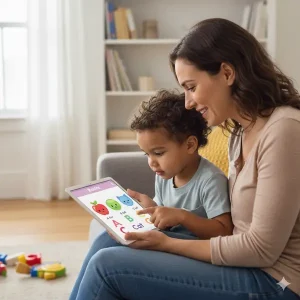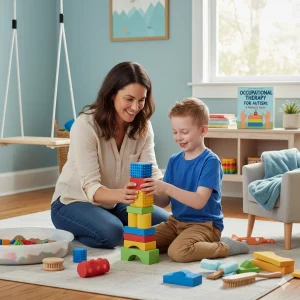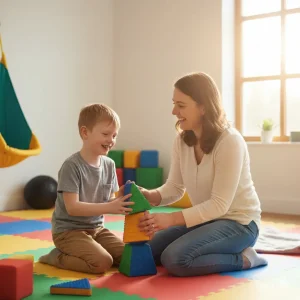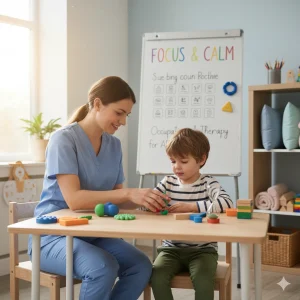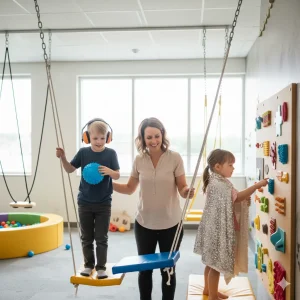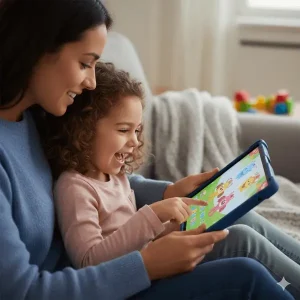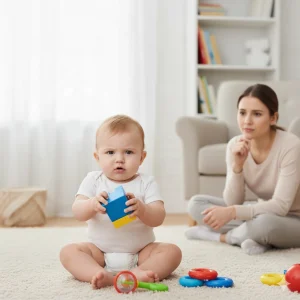Why BASICS is the Best App for Speech and Learning in Autism
By Wellness Hub
Last Updated: October 24, 2025
When your child is on the autism spectrum, every word, sound, and glance feels like a milestone worth celebrating. You want tools that truly understand how your child learns — not just another screen with bright colors and noise. That’s where BASICS stands out.
BASICS isn’t a typical learning app. It’s a therapist-designed program that helps children build speech, language, and focus through structured play and gentle guidance. Each activity in BASICS follows a clear developmental path — from first words to full conversations — so your child can learn at their own pace while having fun.
Unlike other apps that overwhelm with endless animations, BASICS uses calm visuals, real-life images, and voice cues to keep learning consistent and meaningful. It supports children of all abilities, helping them practice speech sounds, understand emotions, and connect words with real-life experiences.
In this article, you’ll discover why BASICS App has become the go-to speech and learning app for children on the spectrum — and how it bridges the gap between therapy sessions and everyday life at home.
Understanding How Children on the Spectrum Learn
Children on the spectrum learn best through structured, predictable, and visual learning experiences. Their brains process information differently, so creating an environment that supports consistency and clarity helps them absorb and retain new skills more effectively.
The Role of Structure and Repetition in Early Learning for Autistic Children
Structure gives children a clear idea of what to expect. When learning follows a consistent sequence, children feel secure and confident. Repetition strengthens that sense of familiarity and helps them master new words, actions, and routines faster.
Apps like BASICS use structured learning paths and repeated play cycles to reinforce speech, vocabulary, and comprehension. For example, when a child repeatedly matches animals or hears a sound-word pair, their brain builds stronger language connections. Regular repetition turns practice into understanding, which is essential for speech and cognitive development in autism.
Why Visual Support and Predictable Routines Improve Comprehension
Visual support makes abstract concepts clear. Children on the autism spectrum often respond better to images, icons, and video modeling than to verbal instructions alone. Visual cues guide attention, reduce confusion, and make learning more concrete.
In BASICS App, each activity includes visual prompts that show what to do next—helping children connect pictures to meaning. Predictable routines, such as a fixed order of activities or familiar background sounds, further enhance focus. When a child knows what comes next, they can process information calmly and respond confidently. This combination of visuals and routine supports receptive language skills and emotional regulation during learning.
The Need for Engaging, Non-Overstimulating Environments for Progress
An effective autism learning environment must keep a child engaged without overwhelming their senses. Too much animation, sound, or unpredictability can cause distraction or withdrawal. Balanced design—simple visuals, soft colors, and clear instructions—helps children stay focused and relaxed.
The BASICS App uses gentle animations, soothing sounds, and therapist-approved pacing to maintain interest while minimizing sensory overload. Each game encourages active participation while keeping the experience calm and predictable. This thoughtful balance allows children to practice attention, communication, and self-regulation, leading to meaningful progress over time.
The BASICS App Approach — Designed by Therapists, Built for Real Progress
The BASICS App was created by a team of speech-language pathologists and occupational therapists who understand how children with autism and speech delay learn best. Every feature in the app is based on years of real therapy experience, designed to make early communication, attention, and learning easier for parents to support at home.
BASICS App uses a structured, developmental hierarchy that mirrors natural child development — starting from sound imitation and first words, moving toward phrases, sentences, reasoning, and social communication. Each level introduces new challenges only when a child masters the previous one. This therapist-driven sequence helps children build speech, comprehension, and confidence step by step, without pressure or confusion.
Unlike open-ended apps, BASICS follows a goal-based learning model. Each goal targets a specific skill area—such as matching and memory, WH questions, or sentence formation—so parents can clearly see what their child is working on. The progress tracker shows completed activities and areas for improvement, helping parents and therapists reinforce the same goals across daily routines.
This method turns screen time into purposeful learning time, giving every child a clear path from understanding to expression. By blending structured milestones with interactive play, BASICS ensures real, measurable progress in speech, attention, and cognitive growth.
Also read: How BASICS App Builds Early Learning Foundations Through Play
Speech Development Made Playful and Predictable
BASICS turns speech therapy into a joyful, predictable learning experience for children on the spectrum. Each activity blends play, structure, and visual clarity, helping children practice speech at their own pace without pressure.
How BASICS App Targets Sound Imitation, First Words, and Articulation
Children with speech delay or autism often need structured repetition and clear visual feedback. BASICS focuses on sound imitation, first word formation, and articulation through step-by-step play. Every level uses therapist-designed prompts that guide your child from simple sounds to meaningful words and sentences.
In the early levels, children listen to familiar sounds—like animals, vehicles, or actions—and imitate them using playful visual cues. This builds sound awareness and helps them connect what they hear to what they say. The app then moves toward naming everyday items such as fruits, toys, or actions, encouraging word retrieval and expression.
For articulation, BASICS uses clear models and repetition. Kids repeat target sounds within fun mini-games and picture-based tasks, helping them master clarity and pronunciation. Because each activity follows a predictable pattern, children feel secure, focused, and motivated to try again—without frustration.
Using Video Modeling and Visual Cues to Support Expressive Speech
Video modeling is one of the most effective techniques for children with autism or speech delays. BASICS integrates this approach seamlessly. Children watch and imitate real speech models, learning how to move their lips, tongue, and jaw to produce clear sounds.
Every visual prompt includes expressive facial cues and matching audio, allowing children to link visual gestures with spoken words. This dual input strengthens speech motor planning and encourages spontaneous imitation. Predictable repetition across sessions helps children build confidence, attention, and consistency—key skills for expressive language development.
Examples: Word Wonders, Phrase Park, and Sentence Symphony Levels
BASICS introduces speech milestones across structured learning paths:
- Word Wonders – Builds first words and object naming through video modeling and repetition. Children hear, see, and say words like “apple,” “run,” or “ball,” strengthening recognition and speech initiation.
- Phrase Park – Expands single words into two- and three-word phrases like “eat apple” or “push car.” Visual sequences make it easier for children to combine words naturally during play.
- Sentence Symphony – Guides children to form complete sentences using real-life visuals. They learn to describe actions, use pronouns correctly, and speak in structured, meaningful ways.
Each level follows a predictable format, reinforcing speech through fun, visual, and interactive repetition. BASICS keeps practice engaging while ensuring every session builds on previous progress—making speech development truly playful, structured, and effective.
Language and Comprehension Through Everyday Contexts
Children on the spectrum learn best when language is connected to real-life situations. The BASICS App brings speech and comprehension together through interactive, visual-based learning that mirrors daily experiences. Every activity helps your child understand, respond, and use words with meaning—turning playtime into powerful language practice.
Interactive Learning in Inquiry Island (WH Questions)
The Inquiry Island level in BASICS App is designed to build comprehension through WH questions—what, where, who, when, why, and how. These questions encourage thinking, reasoning, and conversation.
Your child doesn’t just hear a question; they see a situation, listen to a clear audio prompt, and choose the correct answer. For example:
- “What is the boy eating?” – child taps the image of the apple.
- “Where is the cat sleeping?” – child selects the bed.
This visual and auditory pairing helps children process questions, link them to real-world meaning, and improve their receptive language skills. Inquiry Island gently moves from simple identification to reasoning-based questions, teaching children how to understand context and form logical answers—a vital skill for communication and early academics.
Teaching Everyday Vocabulary (Animals, Foods, Actions, Emotions)
BASICS App introduces language through categories that children encounter daily—animals, fruits, vegetables, food, actions, and emotions. Each word comes with clear visuals, real sounds, and spoken models, making vocabulary learning multi-sensory and memorable.
When your child sees a picture of a dog, hears the bark, and taps the word “dog,” they form a strong word-object connection. The same process applies to everyday actions like eating, running, or sleeping, helping children link verbs with meaning and use them in short phrases.
Emotions, too, are taught through relatable visuals—happy, sad, angry, surprised—so children can recognize and name feelings. This approach goes beyond rote naming; it builds contextual understanding that supports both receptive and expressive language growth.
How Visual Prompts Improve Receptive Understanding
Visuals are the heart of BASICS learning. Children understand faster when they can see what they hear. Every activity pairs language with illustrations, real-life images, or short clips, giving children clear context for comprehension.
When the app says “Show me the apple,” your child immediately associates the sound of the word with the correct image. This visual prompting technique strengthens listening comprehension and ensures that understanding builds before speech emerges.
The combination of audio cues, visual reinforcement, and repeated exposure helps children recognize patterns, predict outcomes, and respond accurately. It turns passive listening into active learning, especially helpful for children with autism or speech delays.
Building Social Communication and Emotional Awareness
Social communication is more than talking—it’s about connecting, sharing, and understanding emotions. The BASICS App helps children on the autism spectrum build these foundational skills through structured, visual, and interactive play. Every activity is designed to strengthen joint attention, eye contact, turn-taking, and emotional understanding, which are crucial for communication growth.
How BASICS App Encourages Joint Attention, Eye Contact, and Turn-Taking
Children with autism often need extra support to develop shared attention and reciprocal communication. BASICS uses clear visuals, engaging animations, and predictable interactions to make these skills easier to practice.
When a child taps, listens, or waits for a cue inside the app, they naturally learn to look, focus, and respond. Activities encourage joint attention—looking at the same object or event together—by using sound prompts and simple actions like pointing, naming, or following instructions.
Each game motivates children to maintain eye contact with on-screen characters and follow turn-taking cues like “your turn” and “my turn.” These elements help children practice social timing, anticipate responses, and stay engaged longer during interactions. BASICS makes these moments playful and rewarding, helping children connect more meaningfully with people around them.
Activities That Help Children Understand Feelings, Routines, and Behavior
BASICS teaches children to recognize and label emotions in everyday situations. Through visual storytelling and guided feedback, kids learn to identify expressions such as happy, sad, angry, or surprised. This builds emotional vocabulary and helps children respond appropriately to different social cues.
Routines play a big role in emotional learning. The app includes everyday activity scenarios like getting ready, playing, or sharing toys. These tasks help children link feelings with familiar contexts—learning that waiting, sharing, or helping others can feel rewarding.
Each activity focuses on positive behavior reinforcement. The app celebrates effort through encouraging sounds and rewards, helping children build confidence, patience, and self-regulation. Over time, children begin to connect emotions with actions, an essential skill for both social and academic success.
Levels Like Conversation Circles and Emotions Explorer Explained
The Conversation Circles level introduces children to real-life communication. They learn how to greet, share, ask, and respond using short, structured dialogues. These interactive cards make conversations visual and predictable, so children can practice at their own pace. The focus stays on turn-taking, listening, and expressive language—key social communication milestones.
In Emotions Explorer, children discover how to identify, name, and understand feelings through pictures and guided play. Each card connects emotions to relatable moments, helping children link inner experiences to visual cues. The level encourages emotional reflection and teaches children how to express what they feel, reducing frustration and improving cooperation.
Together, Conversation Circles and Emotions Explorer strengthen both social awareness and emotional regulation. They make it easier for children to communicate confidently, build empathy, and connect naturally with family, teachers, and peers.
Supporting Focus, Routine, and Self-Regulation
Children on the spectrum learn best when routines feel predictable and engaging. BASICS App uses structured play to help kids build focus, attention, and self-regulation skills in a calm, encouraging way. Each activity is carefully designed to strengthen consistency, patience, and self-control—key foundations for both speech and learning growth.
How Structured Play Boosts Attention Span and Predictability
- Structured play in BASICS gives children a clear beginning, middle, and end to every task. This helps them understand what to expect next, reducing anxiety and improving attention span.
- Each level introduces activities in gradual difficulty—so a child learns to stay with a task longer, follow patterns, and anticipate outcomes.
- Consistent visual prompts, guided voice cues, and repeatable sequences help children maintain focus without feeling overwhelmed.
- This structured format also mirrors the predictable routines used in therapy sessions, giving parents a simple way to practice attention-building skills at home.
The Role of Positive Reinforcement and Goal Completion Badges
Children respond well to encouragement and visible progress. BASICS rewards every small achievement with goal completion badges, praise animations, and encouraging audio cues.
This immediate feedback motivates children to keep trying, strengthening their intrinsic motivation and consistency.
Parents can track how often their child completes a goal, making progress visible and rewarding.
This approach reflects key principles of behavioral reinforcement in autism learning, helping children link effort with positive outcomes.
Helping Children Develop Patience, Sequencing, and Calm Responses
- Through guided play, BASICS teaches children to wait, follow steps, and stay calm even when a task feels challenging.
- Activities that involve sequencing, matching, or turn-taking naturally build patience.
- Visual and audio cues help children process instructions in small steps, promoting calm and regulated responses.
- Over time, this consistent exposure helps children handle transitions better, complete multi-step tasks, and respond more smoothly in real-life situations.
- Parents notice their child becoming more focused, patient, and confident—not through pressure, but through playful learning.
Why Parents and Therapists Trust BASICS App
Parents and therapists trust the BASICS App because it blends structured therapy design with the flexibility of home learning. The app turns daily routines into learning opportunities, helping children build speech, language, and cognitive skills through play. Every activity inside BASICS—whether it’s matching, naming, or sentence-building—is guided by therapeutic principles and progress tracking.
Parent Feedback: “It Fits Easily Into Home Routines”
Parents love that the BASICS App fits naturally into daily routines. Morning, playtime, or bedtime — each moment becomes a chance to practice speech and learning goals.
- Parents use BASICS for 10–15 minutes daily to reinforce what their child learns in therapy.
- Visual cues, voice prompts, and level-based progression make it simple to follow.
- Families appreciate that it’s not another “screen-time” app — it’s a guided learning tool designed for real communication.
The app gives parents control and confidence. They can select specific goals such as articulation, vocabulary, WH questions, or attention, allowing consistent home reinforcement. With built-in progress reports, parents can track milestones and celebrate every small win together.
How Therapists Use BASICS App Alongside Sessions for Carryover Practice
Therapists use the BASICS App as a bridge between therapy sessions and home practice. During online or in-person sessions, they introduce activities that target specific speech or cognitive goals, then assign the same tasks inside BASICS for carryover at home.
Therapists value how the app:
- Reinforces skills through structured repetition.
- Keeps children engaged with interactive visuals and voice feedback.
- Supports both receptive and expressive language goals.
- Tracks data automatically, helping therapists monitor real progress.
By combining direct instruction with BASICS practice, therapists ensure that children retain and generalize skills beyond the therapy room. It encourages parents to stay involved and turn daily play into meaningful learning.
Compatibility with Tele-BASICS and Home-Based Interventions
The BASICS App works seamlessly with Tele-BASICS online therapy. Therapists guide sessions live through video calls while the child interacts with the app in real time. This combination ensures that learning remains structured, visual, and consistent — no matter where the family lives.
Parents who join Tele-BASICS programs can use the same app for home reinforcement, following therapist-assigned goals. The app stores progress data, making it easy for therapists to adjust difficulty levels or introduce new challenges.
This compatibility allows every child—whether in cities or remote areas—to access quality speech and learning support at home. It also helps maintain momentum between sessions, creating continuity and faster results.
Making Therapy Accessible at Home
For parents without regular therapy access — guided learning anytime
Many parents struggle to find consistent speech or learning therapy for their children. Distance, busy schedules, and limited specialists can make regular sessions difficult. The BASICS App fills this gap by bringing therapist-designed speech and learning activities right into your home.
Every activity in BASICS follows a structured plan built by speech and occupational therapists. Parents don’t need formal training—the app gives clear visual guidance, audio prompts, and step-by-step goals that mirror professional therapy sessions. This makes speech and language practice possible anytime, even without weekly visits to a clinic.
Children can learn at their own pace through goal-based levels like Foundation Forest, Word Wonders, and Conversation Circles. These levels cover everything from speech sound practice and vocabulary building to social communication and emotional learning. Each session reinforces real-life skills such as naming objects, answering WH questions, and forming simple sentences.
Parents can track progress through the built-in Goal Mode, which shows completed sets and suggests the next steps. This instant feedback helps families stay motivated and consistent, turning screen time into meaningful learning time.
Whether your child has autism, speech delay, or attention difficulties, BASICS makes therapy accessible, flexible, and engaging. The combination of visual prompts, repetition, and positive reinforcement helps children stay focused and confident while practicing key communication and cognitive skills.
Try BASICS today — support your child’s speech, language, and learning development with guided, play-based therapy at home.
When to Start Using BASICS for Autism
Early intervention makes a powerful difference for children on the autism spectrum. The BASICS App is designed for children aged 2 to 8 years, covering the most critical years for speech, learning, and social development. It helps parents begin structured learning at home—even before formal therapy starts.
Suitable Ages (2–8 Years) and Early Signs to Look For
You can start using BASICS for autism as early as age 2. The app’s activities are created by speech and occupational therapists to match a child’s developmental stage.
If you notice that your child:
- does not respond to their name,
- uses limited words or gestures,
- avoids eye contact,
- prefers objects over people, or
- struggles to imitate sounds or actions,
then it’s time to introduce play-based speech learning with BASICS. Early use helps your child develop attention, imitation, and first words—key foundations for communication.
Each level grows with your child, from matching and sound recognition in Foundation Forest to phrases and WH questions in Inquiry Island and Phrase Park. The app adapts as your child progresses, keeping learning engaging and age-appropriate.
How BASICS app Complements Speech Therapy, ABA, or Special Education Programs
BASICS works best as part of your child’s daily therapy routine. It complements speech therapy, ABA sessions, and special education programs by reinforcing what your child learns with professionals.
Therapists often use BASICS activities such as Word Wonders and Articulation Adventures to practice speech sounds and vocabulary between sessions. The app’s visual cues, repetition, and reward system help maintain consistency and generalization—essential for children with autism.
In ABA or classroom programs, parents can use BASICS App to strengthen language comprehension, social communication, and emotional regulation through structured play. It bridges home and therapy, ensuring progress continues beyond formal sessions.
Recommended Daily Routines for Optimal Learning Time
A consistent routine helps children with autism feel secure and focused. Set aside 15–20 minutes twice a day for BASICS app sessions—once in the morning and once in the evening.
Here’s an ideal routine:
- Morning (10–15 mins): Use Foundation Forest or Word Wonders to build attention and vocabulary.
- Afternoon (15 mins): Explore Phrase Park or Inquiry Island to practice answering questions and forming short phrases.
- Evening (10 mins): End with Emotions Explorer or Conversation Circles to reinforce social and emotional learning.
Parents should sit beside the child, model responses, and celebrate small wins. Consistency matters more than duration—the more regular the practice, the stronger the progress.
By starting early, combining BASICS App with therapy, and following a steady routine, parents can create meaningful learning opportunities every day. The app turns ordinary moments into interactive speech and learning sessions for children on the autism spectrum.
Why BASICS Works for Children on the Spectrum
BASICS helps children on the autism spectrum build real communication and learning skills through structured, play-based experiences. The app combines therapist-designed activities with parent-led practice, giving families the perfect balance of structure and flexibility.
Every session in BASICS App turns screen time into a guided learning opportunity—where children speak, think, and engage with purpose.
- Structured yet flexible routines keep progress consistent and predictable.
- Visual and verbal cues help children understand and respond with confidence.
- Motivating rewards and goal tracking make learning fun and meaningful.
- Therapist-backed design with parental guidance ensures steady speech, language, and attention growth at home.
With BASICS, your child doesn’t just play—they learn to communicate, connect, and grow through every interaction.
About Wellness Hub
Wellness Hub is a trusted digital platform that empowers parents, caregivers, and professionals with science-backed tools for childhood development. From online speech therapy to home therapy resources, we offer a holistic ecosystem for children facing speech delays, autism, ADHD, and other developmental challenges.
Rooted in evidence-based practices and delivered by certified experts, Wellness Hub bridges the gap between accessibility and quality care. Whether you need at-home speech strategies, developmental checklists, or interactive mobile apps like BASICS App, we make early intervention affordable and family-friendly.
Start your journey today with expert guidance tailored to your child’s unique communication and learning needs—anytime, anywhere.
Frequently Asked Questions
1. Can the BASICS app replace speech therapy for autism?
No. BASICS doesn’t replace therapy—it supports it. The app helps children with autism practice speech, language, and comprehension at home between therapy sessions. Parents and therapists use BASICS to reinforce goals, making speech learning consistent and engaging.
2. How does BASICS help nonverbal children start communicating?
BASICS helps nonverbal children imitate sounds, understand words, and use gestures or visuals to express needs. Levels like Word Wonders and Phrase Park encourage sound imitation and word recognition, helping children move from gestures to speech naturally.
3. Is the BASICS app suitable for children with sensory sensitivities?
Yes. BASICS uses soft visuals, predictable sounds, and minimal distractions to support sensory-sensitive learners. Parents can adjust pace, sound, and visual exposure so every child learns in a calm, comfortable environment.
4. What makes BASICS different from other autism learning apps?
BASICS stands out because therapists designed every activity for real developmental progress. The app combines speech therapy, cognitive skills, and emotional learning under one system. Parents can track growth through Goal Mode and personalize practice through Library Mode—something most apps don’t offer.
5. How often should my child use BASICS for visible improvement?
Children benefit most when they use BASICS for 15–20 minutes daily. Consistent short sessions help them retain words, improve attention, and strengthen speech patterns faster than irregular long sessions.
6. Can parents use BASICS without professional guidance?
Yes. BASICS gives parents step-by-step guidance, progress tracking, and clear instructions for every level. Even without a therapist, parents can follow visual cues and daily goals to help their child practice speech safely and effectively at home.
7. What age group benefits most from BASICS?
BASICS suits children aged 2 to 8 years, covering the critical early intervention window. The app adapts to each child’s ability level, from first words to sentence building, making it useful for both toddlers and school-age children on the spectrum.
8. Does BASICS work for both verbal and nonverbal autistic children?
Yes. BASICS supports all communication levels—from children who use no words to those forming full sentences. Activities promote sound imitation, labeling, picture recognition, and sentence formation, helping every child grow from their current stage.
9. How does BASICS improve attention and focus in autistic kids?
BASICS builds attention through short, goal-based tasks and interactive visuals. The structured play design encourages focus, task completion, and motivation without overwhelming the child, making it ideal for kids with limited attention spans.
10. Can I combine BASICS with in-person or online therapy?
Yes. Many parents and therapists combine BASICS with in-person or Tele-BASICS sessions to maintain progress between appointments. Using the app alongside therapy ensures daily reinforcement and faster communication growth.
Book your Free Consultation Today
Parent/Caregiver Info:
Client’s Details:
* Error Message
